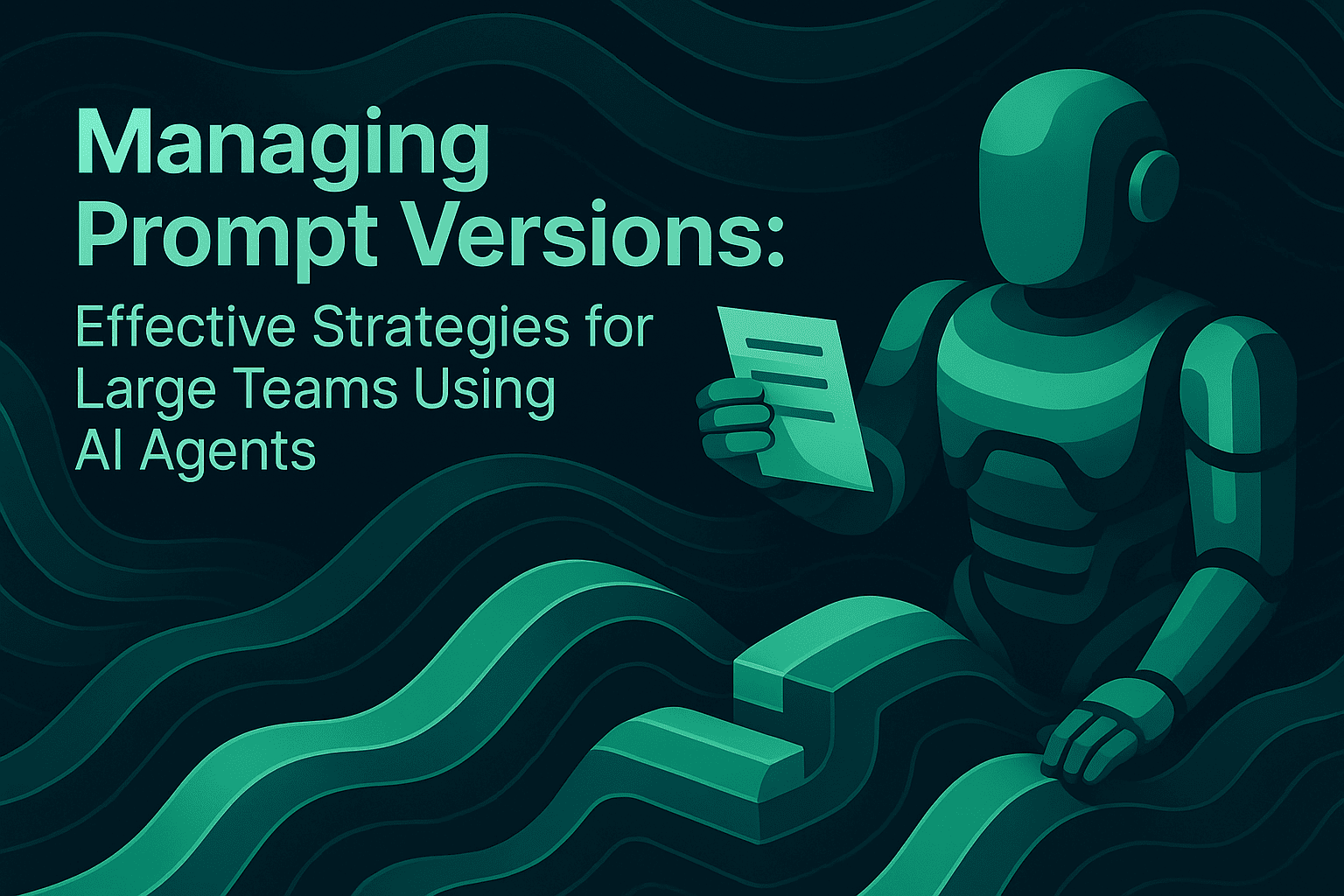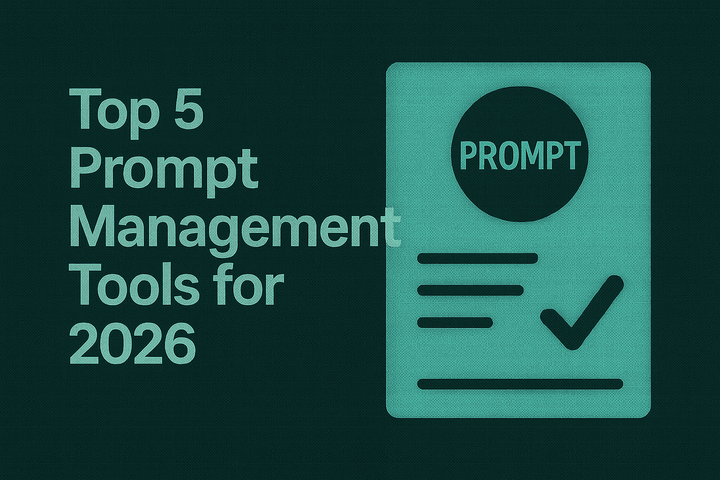Managing Prompt Versions: Effective Strategies for Large Teams Using AI Agents

TL;DR
Large teams building AI agents need structured prompt versioning to ship changes confidently and roll back safely. Treat prompts like code: maintain version history, link versions to evaluators, and deploy with control using canary cohorts and A/B testing. Combine side-by-side comparisons, comprehensive evaluation (deterministic checks + LLM-as-a-judge + human review), and production observability to prevent regressions. Use deployment variables to target cohorts, instrument traces to monitor impact, and enable one-click rollbacks when metrics slip. This guide provides team-centric workflows and practical checklists to keep prompt engineering reliable across fast-moving products.
Large teams building AI agents need prompt versioning that is structured, testable, and observable. The goal is simple: make changes confidently, measure impact, and roll back safely when results deviate from expectations. This guide outlines team-centric workflows and practical tools to keep prompt engineering reliable across fast-moving products.
Why Prompt Versioning Matters for Teams
Prompt versioning is the backbone of coordinated AI development. In multi-team environments, prompt changes affect downstream tools, retrieval pipelines, and user experiences. Treat prompts like code: maintain version history, document change rationale, and link each version to evaluators and deployment variables. Maxim AI's guidance on side-by-side prompt comparison explains how running identical inputs against prompt variants and models isolates quality, latency, and cost differences in a controlled way. This approach is essential for consistent team workflows.
For teams, versioning reduces noise in experiments, helps track prompt drift over time, and supports operational decisions like choosing safer defaults for customer-facing flows. When prompt changes are versioned with metadata and tied to evaluation runs, engineering and product can align on what changed, why it changed, and how it impacts outcomes.
Common Scaling Problems to Address Early
As prompts multiply across agents and markets, teams often hit the same issues:
- Naming conflicts: Different squads iterate on the same base prompt and accidentally overwrite changes. Avoid this with version tags, folders, and deployment variables that define ownership and scope.
- Testing gaps: Ad-hoc checks miss edge cases. Without bulk, repeatable tests on representative datasets, quality regressions go live unnoticed.
- Format drift: Downstream tools and integrations rely on structured outputs. Small wording changes break parsing or function-calling schemas.
- Hidden dependencies: A single prompt powers multiple personas or surfaces. Without dependency mapping, rollbacks fix one area but break another.
- Unclear rollout strategy: Shipping a new prompt to all users at once leads to avoidable incidents. Without canary cohorts and A/B rules, teams lack control over exposure.
Maxim AI's prompt management documentation emphasizes structured versioning, evaluators at scale, and production observability. These guardrails prevent issues before they reach users.
Workflows and Tools That Keep Teams in Sync
A practical workflow connects experimentation, evaluation, deployment, and observability:
Version and organize
Use a central prompt workspace with versions, sessions, folders, and descriptive tags. Link versions to the models and parameters they target. Version descriptions should capture change rationale and intended impact on agent behavior. Add structured metadata such as author, timestamp, approval status, model config, and links to evaluation runs for full traceability.
Compare side by side
Run controlled experiments where the input dataset stays constant and one factor changes at a time, such as examples, system instructions, or parameters. Aggregate win/loss outcomes, latency percentiles, and token spend to inform deployment decisions. Side-by-side comparison is especially effective for isolating quality changes without confounding variables. Incorporate statistical checks and LLM-as-a-judge evaluations for layered validation.
Evaluate comprehensively
Combine automated checks for structure and constraints with LLM-as-a-judge for nuanced correctness, then add human review for high-stakes outputs. Evaluations should be linked directly to the prompt version so every change is backed by evidence. Use production logs to continuously improve test datasets through data curation, and include edge cases, adversarial inputs, and known failure patterns.
Deploy with control
Use rule-based deployment variables to target cohorts by environment, locale, or customer segments. Apply approval gates, A/B testing, and gradual rollouts to reduce risk. Keep deployment decoupled from code so teams can iterate quickly while maintaining traceability. Support semantic versioning schemes: major for breaking changes, minor for refinements, and patch for fixes.
Observe and roll back
Instrument agents with tracing and log prompt-completion pairs. Monitor task completion, faithfulness to sources in retrieval workflows, latency, errors, and cost per interaction. When metrics slip, roll back to a known-good version quickly and re-run simulations to confirm recovery. Add automated alerting and retention policies to meet compliance needs.
Maxim AI's documentation covers product capabilities across experimentation, evaluation, and observability, showing how to connect these steps into reliable team workflows.
Observability and Rollback: How Teams Track Impact
Observability ties prompt versions to production behavior. Teams should:
- Capture spans and sessions across agent steps to see where outcomes diverge.
- Track latency percentiles, streaming quality, retry rates, token spend, and error codes for each prompt version in production.
- Run periodic automated evaluations on live traffic to detect quality drift early.
- Curate datasets from logs, especially failure cases, to strengthen pre-release tests.
When a new version underperforms, perform a one-click rollback to the previous version. Validate that metrics return to expected ranges, and document the incident with links to the evaluation runs and traces. Production-grade observability turns rollbacks into a safe, quick operation rather than a guess.
A Team Checklist for Prompt Versioning at Scale
Use this checklist to keep workflows disciplined and collaborative:
Versioning and ownership
- Maintain semantic versions and publish detailed change notes.
- Organize prompts by application and team folders; apply tags for retrieval via SDKs.
- Link each version to metadata: model, parameters, authors, date, environment, evaluation status.
Datasets and evaluators
- Build representative, multi-turn datasets that include edge cases.
- Configure layered evaluators: deterministic checks, statistical metrics, LLM-as-a-judge, and human review where needed.
- Regularly refresh datasets using production logs to reflect real-world variation.
Side-by-side testing
- Hold inputs constant and vary one factor at a time.
- Aggregate win/loss outcomes, compute significance, and slice by persona or scenario.
Deployment control
- Use approval gates, canary cohorts, and A/B rules tied to deployment variables.
- Decouple prompt deployment from application releases to iterate without blocking.
Observability and tracing
- Instrument spans and sessions; correlate prompt versions with runtime behavior.
- Monitor latency, cost, error rates, and task success by version.
- Track rollback events and post-incident simulations to improve future tests.
Rollback readiness
- Enable one-click reversion; pin versions to affected cohorts when needed.
- After rollback, re-run simulations and evaluators to validate recovery.
Continuous improvement
- Feed production logs into the data engine; extract failure cases to expand test suites.
- Refresh evaluators and prompt variants periodically to prevent drift.
- Involve cross-functional teams in review cycles to improve alignment and accountability.
Putting It Into Practice with Maxim AI
Maxim AI provides end-to-end capabilities that align with this workflow:
Experimentation: A collaborative prompt IDE for versioning, deployment variables, and cross-model comparisons that simplifies decisions across quality, cost, and latency.
Evaluation: Unified machine and human evaluators that quantify improvements or regressions across datasets and versions. Review deeper guidance on LLM-as-a-judge for agentic applications to ensure evaluations are consistent and cost-efficient.
Observability: Real-time logs, distributed tracing, automated quality checks, and the ability to curate datasets from production to sustain reliability and support rollbacks with confidence.
For teams standardizing prompt engineering, these capabilities help move from ad-hoc edits to governed, measurable changes that scale across products and markets.
Conclusion
Managing prompt versions at scale is a coordination and reliability challenge. With disciplined versioning, structured evaluation, controlled deployment, and strong observability, large teams can iterate quickly while maintaining quality. Side-by-side comparisons, LLM-as-a-judge evaluators, and production tracing form the core of this approach. Maxim AI's documentation and platform provide practical guidance and capabilities to operationalize these workflows across the full AI lifecycle.
Start improving reliability with standardized prompt management across your teams: Request a demo or Sign up.
Read Next
Version Control for Prompts: The Foundation of Reliable AI Workflows Learn how to implement version control systems for prompts, track changes across iterations, and establish governance frameworks that prevent conflicts in multi-team environments.
How to Perform A/B Testing with Prompts: A Comprehensive Guide for AI Teams Discover practical strategies for running statistically valid A/B tests on prompt variants, measuring impact across quality and cost dimensions, and making data-driven deployment decisions.
Agent Observability: The Definitive Guide to Monitoring, Evaluating, and Perfecting Production-Grade AI Agents Explore comprehensive observability practices for AI agents, including trace instrumentation, session-level metrics, and strategies for identifying and resolving production issues before they impact users.


